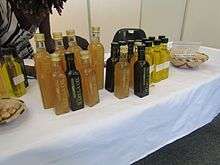Marula oil

Marula oil is extracted from the kernels (nuts) of the fruits of the Marula trees (Sclerocarya birrea), from the Anacardiaceae family. There are two types of Marula oil, the oil extracted from the seeds and the oil extracted from the nut's hard shell. Marula oil is traditionally used in cosmetics, in food as a cooking oil and as a meat preservative and to treat leather.
Chemical composition
Marula oil contains a large proportion of monounsaturated fatty acids and natural antioxidants which make the oil very stable. The fatty acid composition of marula oil includes:[1]
Mono-unsaturated fatty acids:
- Oleic acid (70-78%)
Polyunsaturated fatty acids:
- Linoleic acid (4.0-7.0 %)
- Alpha-linolenic acid (0.1-0.7 %)
Saturated fatty acids:
- Palmitic acid (9-12%)
- Stearic acid (5.0-8.0 %)
- Arachidonic acid (0.3-0.7 %)
Tocopherols, sterols and flavonoids, with antioxidant action, procyanidin, galattotannin and catechins are also found in marula oil.[2]
Physical properties
Marula oil has a clear, light yellow colour and a nutty aroma. It has a saponification value of approximately 188-199 and a specific gravity of 0.91-0.92 (at 15°C).[3]
Traditional uses
The Tsonga people of South Africa and Mozambique have used the oil as a moisturising body lotion for women and also as a massage oil for babies. In the past, women used Marula oil rather than water to clean themselves.[4]
Marula oil forms also an important part of people's diets, especially for people of the Inhambane Province in Mozambique, Owambo in north central Namibia, Northern KwaZulu-Natal in South Africa and the Zvishavane district of Zimbabwe. Furthermore, marula plays an important role in the diet of Bushmen and Bantu tribes.[5][6] The Venda utilise the oil from the kernels to preserve meat, which enables it to last up to a year. Today, Marula oil is still considered a delicacy by local people, and is added to a wide variety of traditional and modern recipes.[4]
Applications
Studies have looked at the oxidation stability, induction period (34 hours), polar compounds, free fatty acids of Marula oil as a frying oil.[7]
References
- ↑ Hore, D. (2004). Formulation of cosmetic skin lotions using Adansonia digitata and Sclerocarya birrea oil from Zimbabwe. University of Zimbabwe, Harare.
- ↑ Mariod; Matthaus, Bertrand; Eichner, K.; et al. (2004). "Fatty acid, tocopherol and sterol composition as well as oxidative stability of three unusual Sudanese oils". Journal of Food Lipids. 11 (3): 179–189. doi:10.1111/j.1745-4522.2004.01131.x.
- ↑ Hall, J.; et al. (2002). Sclerocarya birrea: a monograph. Publication Number 19. School of Agricultural and Forest Sciences, University of Wales, Bangor.
- 1 2 Botelle, A (2001). A History of Marula Use in North-central Namibia. Windhoek, Namibia: Eudofano Women’s Co-operative Ltd and CRIAA SA-DC.
- ↑ Engelter & Wehmeyer; Wehmeyer, A.S. (1970). "Fatty acid composition of oils of some edible seeds of wild plants". Journal of Agricultural and Food Chemistry. 18: 25–26. doi:10.1021/jf60167a025.
- ↑ Shackleton, S.E.; et al. (2002). A summary of knowledge on Sclerocarya birrea with emphasis on its importance as a NTFP in South and Southern Africa. Part 1.
- ↑ Mariod; Matthäus, Bertrand; Eichner, Karl; Hussein, Ismail H.; et al. (2006). "Effects of processing on the quality and stability of three unconventional Sudanese oils". European Journal of Lipid Sciences and Technology. 108 (4): 298–308. doi:10.1002/ejlt.200500323.